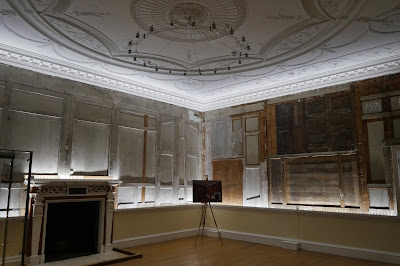Croome Court
Merv and I have just visited Pershore, but I had a feeling when I was planning it that we might feel slightly disappointed so I proposed a visit to walk around Croome as well. I found it on the National Trust website. I didn't realise what a delight it would be.
We arrived to find what looked to be a newly established visitor centre housed in a load of Nissen huts. We emerged to be routed towards the interesting RAF museum. We gradually came to understand that a large slice of land which was part of Croome was taken over during the war as a secret RAF base, known as RAF Defford, which undertook research and development on airborne radar. More than 2,000 service personnel and scientists worked there. So that was rather a surprise.
Now began the walk proper. We wandered along a marked track through woodland and then emerged at a high point overlooking a classic country house park with the great house, Croome Park maybe half a mile away below us. It was a great moment.
To our further surprise a gothick church stood on slightly higher ground to our left.
It is the church of St Mary Magdalene. According to the NT website: A church at Croome is first mentioned in 1283 and was dedicated to St James the Apostle, this church was close to the house but was demolished by George Coventry, the 6th Earl of Coventry, when he inherited the estate in 1751 and set about remodelling the house and landscape. The current church was designed by Capability Brown (who knew he did churches as well as landscaping?). The rather lovely interior was by Robert Adam.
We headed past the ice house ...
... to reach the lovely Rotonda. This was also the work of Capability Brown and dates from the 1760s.
It is a bit battered inside.
We walked around the privately owned walled garden and past the Victorian wing to come to the imposing rear facade of Croome Court. The key to understanding what follows is that it remained in the Coventry family until 1948 but was then sold as the family had fallen on hard times. It then passed through the hands of several property developers as it gradually declined. The Natiaonl Trust bought the park in 1996 and the Croome Heritage Trust was formed to buy the house in 2007. It is now leased to the National Trust, which is presumably finding the renovation work.
The entrance is on the other side, so we continued clockwise, this view showing us more of the layout and with the church in the distance.
Off to the left was the long thin lake also designed by Brown with a nice wooden bridge.
Inside, the house is undergoing a substantial renovation. This is Adam's wonderful long gallery. Apparently it was his first complete room.
There is no furniture and there are no paintings, so the Trust has bravely put sundry modern art works in place to reduce the emptiness. I can see why they have done it, but it is not entirely successful to my mind. The modern and the Georgian are rather discordant.
Further along we came to the Tapestry Room. Sadly, the tapestries were long ago sold to a French dealer to cover a gambling debt and then to American buyers and are now in the Metropolitan Museum of Art in New York. All that remains is the frames on which they would have been mounted and the ornate ceiling.
We wondered round the rest of the house, but there was little of interest to see. Upstairs rooms once used as classrooms, that sort of thing.
Leaving Croome Court we headed across the grounds towards the Orangery but couldn't reach it as a ha-ha lay in the way. That felt like the cue to finish, so we returned to the car park and headed home.
Conditions: grey, cool.
Distance: 2 or 3 miles.
Rating: four stars. A wonderfully interesting experience.












No comments:
Post a Comment